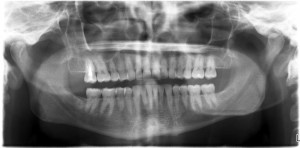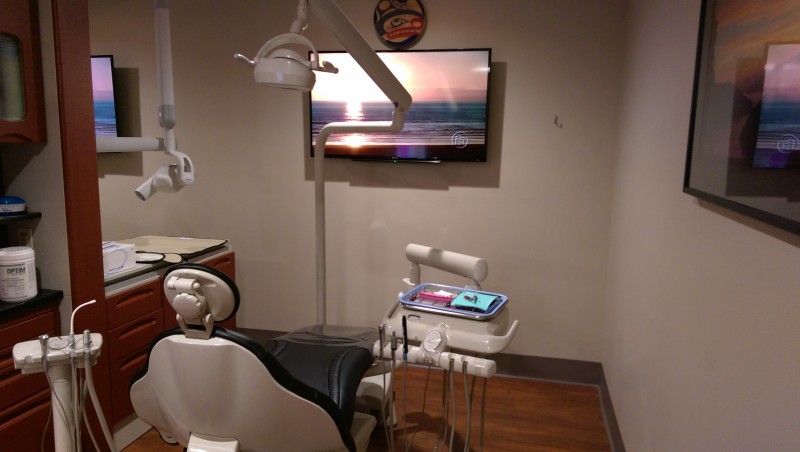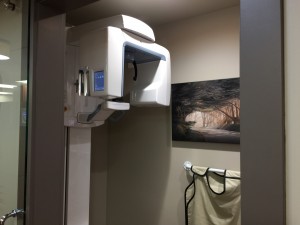Technology at Sunny Tatra: Panoramic X-Ray
In this installment of Technology at Sunny Tatra, we profile panoramic x-rays and their benefits. Dr. Sunny Tatra continues to be committed to providing his clients with modern technology and equipment in order to create the best dental experience possible.
What is it?
Panoramic X-rays show a broad view of the jaws, teeth, sinuses, nasal area, and jaw joints. These X-rays are not used to find cavities; rather they show problems such as impacted teeth, bone abnormalities, cysts, solid growths (tumors), infections, and fractures.Panoramic radiography, also called panoramic x-ray, is a two-dimensional (2-D) dental x-ray examination that captures the entire mouth in a single image, including the teeth, upper and lower jaws, surrounding structures and tissues.The jaw is a curved structure similar to that of a horseshoe. However, the panoramic x-ray produces a flat image of the curved structure. It is typically set to provide details of the bones and teeth.
How does the procedure work?
X-rays are a form of radiation like light or radio waves. X-rays pass through most objects, including the body. Once it is carefully aimed at the part of the body being examined, an x-ray machine produces a small burst of radiation that passes through the body, recording an image on photographic film or a special detector. During a panoramic x-ray examination, the x-ray tube rotates in a semicircle around the patient’s head, starting at one side of the jaw and ending at the other side.Rather than relying on film placed inside the mouth, a panoramic x-ray machine projects a beam through the patient onto film or a detector rotating opposite the x-ray tube.Until recently, x-ray images were maintained as hard film copy (much like a photographic negative). Today, most images are digital files that are stored electronically. These stored images are easily accessible and are frequently compared to current x-ray images for diagnosis and disease management.The digital format also allows the dentist to adjust and change the contrast, brightness and darkness of the image for better visualization of certain structures and tissues. Images on film cannot be adjusted or changed.
During a panoramic x-ray examination, the x-ray tube rotates in a semicircle around the patient’s head, starting at one side of the jaw and ending at the other side.Rather than relying on film placed inside the mouth, a panoramic x-ray machine projects a beam through the patient onto film or a detector rotating opposite the x-ray tube.Until recently, x-ray images were maintained as hard film copy (much like a photographic negative). Today, most images are digital files that are stored electronically. These stored images are easily accessible and are frequently compared to current x-ray images for diagnosis and disease management.The digital format also allows the dentist to adjust and change the contrast, brightness and darkness of the image for better visualization of certain structures and tissues. Images on film cannot be adjusted or changed.
Uses
A panoramic x-ray is a commonly performed examination by dentists and oral surgeons in everyday practice and is an important diagnostic tool. It covers a wider area than a conventional intraoral x-ray and, as a result, provides valuable information about the nasal area, maxillary sinuses, tooth positioning and gum and bone irregularities. This examination is also used to plan treatment for full and partial dentures, braces, extractions and implants.
Benefits
- Unlike a traditional intraoral x-ray where the film is placed inside of the mouth, the film for a panoramic x-ray is contained inside of the machine.
- No radiation remains in a patient’s body after an x-ray examination.
- X-rays usually have no side effects in the typical diagnostic range for this exam.
- Panoramic x-rays can be used for very young children since the film does not have to be placed inside the mouth.

- Easier for Dr. Sunny Tatra, the team, and patients. Dentists can now consistently open up the contacts between the posterior teeth simply by adjusting the panoramic positioning light, compared to setting up a sensor in a holder, placing it in the patient’s mouth, aiming the X-ray machine, and repeating several of these steps for each of the subsequent bitewing exposures.
- Faster. The panoramic technique requires fewer steps than traditional dental X-rays. Dr. Sunny Tatra and the team can turn on the machine and seconds later have images ready for viewing. Patients can easily stand or sit during the panoramic X-ray examination that can be performed once, as opposed to a bitewing series of up to four X-ray exposures that take several steps, some of which may be uncomfortable for patients.
Why it is important to take a Panoramic X-ray every 5 years
- Evaluate jaw growth & facial bones
- Analyze tooth positioning and impactions
- Assess sinuses and surrounding tissues
- Check for gum and bone irregularities, developmental abnormalities or anomilies
- View temporal mandibular joint (TMJ) for any disorders
- Detect fractures in bone
- Assess infections
- Identify various cysts or tumours
Remember to follow and like Dr. Sunny Tatra on Twitter, Facebook and Google+ to stay up to date with the latest news and tips. To read client reviews or to share your own experience, visit our RateMDs and Yelp pages. To book an appointment with Dr. Sunny Tatra and his team, phone +1 250 590 0166, email, or fill out the online appointment form!




